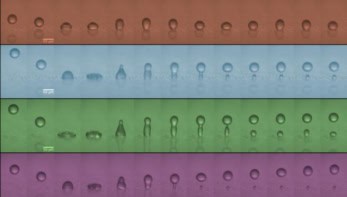Droplets can be made to chase each other around a track and even self-assemble into devices, simply by mixing two everyday liquids. This remarkable discovery made by scientists in the US has already been used to create beautiful shapes and patterns, and could also be exploited to create optical components that assemble themselves and even to clean surfaces.
Surfaces such as glass have a strong attraction to water molecules and many other liquids. As a result, a drop of pure water or propylene glycol will normally spread itself out to form a very thin film on an ultraclean glass surface. On everyday surfaces, however, droplets will often remain stuck at a single point, like a raindrop stationary on a sloping car windscreen. This process is called “contact-line pinning”, and is caused by contaminants and surface roughness.
When he was an undergraduate at the University of Wisconsin-Madison, Nate Cira noticed something unexpected: droplets of water and food colouring mixed together not only endured on a surface but began to dance around each other in elaborate patterns. Cira is now working on a PhD at Stanford University, and has teamed up with Manu Prakash and others to study this curious effect.
Tension and evaporation
Prakash’s team realized that the key to understanding the phenomenon is an effect that was first described in 1865 by the Italian physicist Carlo Marangoni. He pointed out that in a liquid with a surface-tension gradient, fluid is drawn towards the region where the surface tension is higher.
The droplets have a little tornado inside, and that flux is what keeps the droplet from spreading
Manu Prakash, Stanford University
It turns out that this “Marangoni effect” is relevant to food colouring/water mixtures because the propylene glycol used in food colouring evaporates more slowly at room temperature than water. This means that as a droplet spreads on a clean surface, more water than propylene glycol evaporates from the growing surface of the droplet. This means that the concentration of water near the surface of the droplet is lower than in its centre. Propylene glycol has a much lower surface tension than water, which means that the edge of the droplet also has a lower surface tension than the centre. Fluid is therefore pulled into the centre of the droplets by the Marangoni effect, preventing the droplet from spreading further. “The droplets have a little tornado inside, and that flux is what keeps the droplet from spreading,” explains Prakash.
On a clean surface the effect overcomes any pinning caused by roughness, and the droplets are able to move freely and respond to tiny forces. This allows the droplets to interact with each other in surprising ways. If two droplets are close together, the water evaporating from the droplets makes the humidity higher in the gap between droplets than elsewhere in the surrounding air. This means that evaporation will be slower from the inward-facing sides of the drops than it is from sides facing away from the gap, the results being a net force drawing the droplets together.
Two droplets with the same composition will coalesce straight away, but when the composition of the droplets differs significantly, something different happens. They are attracted together initially, but at very short distances they begin to exchange molecules across the gap. This makes the humidity in the gap lower than at the outward-facing side of the droplet with a higher water concentration. This drop will move away from the drop containing less water, and the result is that one droplet chases the other until they both have the same water concentration.
Racetracks and lenses
Variations on these effects allow the team to have droplets chasing each other continuously around a track that is simply drawn on a surface using a marker, which creates hydrophobic lines that the droplets cannot cross. The droplets can also be made to sort themselves and even align themselves on parallel plates, to produce a fluidic lens that could focus an image (see video above). The effects could be seen in any droplets containing two fluids in which one had both a higher surface tension and a higher rate of evaporation than the other, on a variety of ultraclean substrates such as aluminium, silicon and flexible indium tin oxide.
While Prakash says that the work was “purely driven by curiosity”, the researchers believe that the system provides a useful test-bed for exploring many-body physics involving interacting particles. “The experiments are very easy to run but the outcomes are really fascinating,” Prakash says. Beyond this, they are exploring potential industrial uses for cleaning solar cells and silicon wafers without the need for harsh chemicals.
Manoj Chaudhury of Lehigh University in Pennsylvania is impressed: “I think it is definitely a very significant work – in fact it’s a beautiful work…This is a new phenomenon they have discovered – one just has to sit down and find applications.”
The research is described in Nature.



